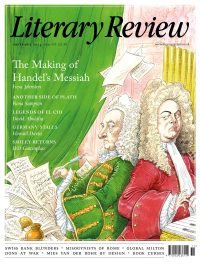Sam Reynolds
Islands in the Sky
Orbital
By Samantha Harvey
Jonathan Cape 136pp £9.99
About halfway through this novel, an astronaut called Pietro reflects that ‘if you could get far enough away from the earth you’d be able finally to understand it’. This is a neat summation of one of the themes of Samantha Harvey’s slim fifth novel, which has been shortlisted for this year’s Booker Prize. Stand as far back as you can imagine and say what you see.
Orbital follows a day in the lives of six astronauts working 250 vertical miles above Earth on the International Space Station (ISS). Pietro is Italian, Roman and Anton are Russian, Nell is British, Shaun is American and Chie is Japanese. They go about their jobs, monitoring microbes or protein crystals, and document their vital signs (‘the pulse measuring, the urine sampling’). The backstory that Harvey establishes for each character is gestural and exists to buttress the novel’s emphasis on existential themes, which include familiar subjects for Harvey (religious faith, art, grief) as well as not so familiar ones (human progress and technology).
Time has often been elastic in Harvey’s work. The Wilderness, her debut novel, portrayed a widowed architect succumbing to Alzheimer’s disease. The Shapeless Unease, published over a decade later, is a memoir about ‘life without sleep, where days merge unbounded’. In Orbital, the shapelessness of time is an external reality. One day on Earth is the duration of a single rotation. By contrast, the ISS orbits the Earth sixteen times in twenty-four hours, meaning that the astronauts on board will see and feel ‘the whip-crack of morning’ every ninety minutes. Or more likely feel no morning at all. In space, time is a sleek stream (‘The past comes, the future, the past, the future’), ‘a day-less freak zone’ of ‘ringing singing lightness’, ‘a giddy mass of waltzing things’.
Another writer might have used this material for a sci-fi novel or exploited the dramatic opportunities of space to write a character study. Harvey opts for neither of these routes. At times, Orbital feels almost like a long poem. Whenever an event threatens to generate plot – Chie’s mother dies suddenly, a typhoon spreads out from the western Pacific – it never causes a serious disturbance or gathers much momentum. As Harvey’s third-person narrator puts it at one point, ‘thoughts run into a wall and expire. Then are reborn’ – one of many passages where the prose seems to make subtle reference to itself. Everything is condensed to the rhythms of orbit, which ‘whittle … down’ the internal life of each character. Shaun ‘sees with absolute clarity the next few moments and is trained not to think of very much else’. Pietro’s thoughts ‘interest him for as long as they need to and then they go’. Things matter and then they don’t.
If the pleasures of this kind of writing are evident, so are the dangers. Orbital might have had too much of ‘a sense of level-headed distance about it’ (not something one tends to want from fiction). Thankfully, it stays focused on people, and things, and the bright blue Earth. ‘Maybe one day’, Pietro muses, ‘a robot could do your job and maybe it will; you have to wonder’. On the evidence of Orbital, Harvey’s job will be safe for a while yet.

Sign Up to our newsletter
Receive free articles, highlights from the archive, news, details of prizes, and much more.@Lit_Review
Follow Literary Review on Twitter
Twitter Feed
It wasn’t until 1825 that Pepys’s diary became available for the first time. How it was eventually decrypted and published is a story of subterfuge and duplicity.
Kate Loveman tells the tale.
Kate Loveman - Publishing Pepys
Kate Loveman: Publishing Pepys
literaryreview.co.uk
Arthur Christopher Benson was a pillar of the Edwardian establishment. He was supremely well connected. As his newly published diaries reveal, he was also riotously indiscreet.
Piers Brendon compares Benson’s journals to others from the 20th century.
Piers Brendon - Land of Dopes & Tories
Piers Brendon: Land of Dopes & Tories - The Benson Diaries: Selections from the Diary of Arthur Christopher Benson by Eamon Duffy & Ronald Hyam (edd)
literaryreview.co.uk
Of the siblings Gwen and Augustus John, it is Augustus who has commanded most attention from collectors and connoisseurs.
Was he really the finer artist, asks Tanya Harrod, or is it time Gwen emerged from her brother’s shadow?
Tanya Harrod - Cut from the Same Canvas
Tanya Harrod: Cut from the Same Canvas - Artists, Siblings, Visionaries: The Lives and Loves of Gwen and Augustus John by Judith Mackrell
literaryreview.co.uk